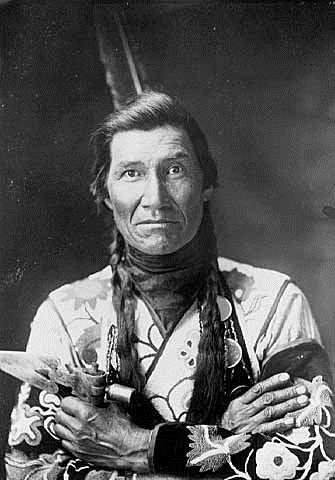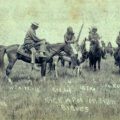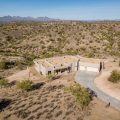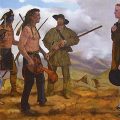
Following the creation of the United States, Mexico was seen by some Indian people as a place of refuge, a place where they might be able to escape from the brutality of American Indian policies designed to eradicate Indian cultures and Indian peoples. Initially Indian groups could obtain sanctuary in Mexico by simply crossing the Mississippi River. During the first half of the nineteenth century, however, American imperialism drove the border between the two countries farther south and following the Mexican American War, the Río Grande (Río del Norte in Mexico) was designated as the border. For the next century, however, many tribes from the eastern United States continued to establish villages in northern Mexico, particularly in the Mexican state of Coahuila where they could continue their languages and traditional ways of life without governmental interference. One of the attempts to relocate in Mexico during the 19th century was led by the Seminole war leader known as Wildcat.
Background: Wildcat and the Seminole
During the 19th century, the United States engaged in a series of three wars against the Seminole in an attempt to remove them from Florida and relocate them in Indian Territory (present-day Oklahoma). Wildcat was one of several Seminole leaders who led small bands against the Americans and their army. While Wildcat led a number of successful raids, the Americans in 1841 began a scorched earth policy in which they burned all of the Seminole crops, homes, canoes, and supplies which they could find. As a result, Wildcat surrendered to the army.
The Americans loaded Wildcat and his people onto boats to begin their removal to Indian Territory. At New Orleans, the Americans stopped the ship and had Wildcat and his warriors return to Florida. The Americans wanted to use Wildcat’s services to convince other Seminole to agree to removal. As a result of Wildcat’s efforts, 211 Seminole were shipped out for Indian Territory.
Background: Mexico
While American-oriented history books often tell about Mexican-based Indian tribes raiding the American ranches and settlements in Texas, New Mexico, and Arizona, Mexico faced a similar problem. Mexico’s northern border was its “wild west” and Mexican settlements in the north were often raided by Comanche, Apache, and other Indian warriors from the United States. Mexico, with limited resources and a small army, was often unable to do much to deter these raids. One way of dealing with the raids was to encourage other Indian groups, including the Cherokee, Seminole, Kickapoo, Delaware, and others, to settle in the area. In addition, the Mexican army often employed these warriors as scouts and soldiers in their wars against the northern raiders.
In 1839, for example, some of the Kickapoo, seeking refuge from the Texans, fled to Mexico where they established a village. Many of the warriors enlisted in the Mexican army where they were used as scouts. The new village also served as a base for the Kickapoo warriors as they raided into Texas communities.
The Mexican Venture
Life for the newly removed Seminole in Indian Territory was not pleasant. First, the climate and ecology of Oklahoma is somewhat different than that of Florida. Second, the Americans, in their infinite wisdom, had placed the Seminole on the lands reserved for the Creek Nation, thus placing them under Creek jurisdiction.
In 1849 Seminole leader Wildcat wanted to separate the Seminole from the Creek government. After a series of discussions with the Mexican government, he decided to locate the new community in the Mexican state of Coahuila. This would place the new Indian community outside of the jurisdiction of the United States. He then visited the Kickapoo, Comanche, Kiowa, Caddo, and Wichita in an attempt to persuade these tribes to join his intertribal venture. Of these, only the Kickapoo showed any interest.
In attempting to persuade the other tribes to join him in Mexico, Wildcat emphasized the many injustices to the Indians committed by both the United States government and the American settlers who had invaded Indian lands. He emphasized the evils of contact with these intruders, and the necessity for a unified Indian resistance to their eternal impositions. His words had a familiar ring to the Kickapoos. The teachings of Tenskatawa (the Shawnee Prophet) and his brother still lingered in the traditions of the Kickapoos. Wildcat’s words were welcomed by them.
In 1850, Wildcat led a party of 250 Seminole and Kickapoo warriors into Mexico where they temporarily settled at Piedras Negras. The Kickapoo were under the leadership of Papequah. The Mexican officials in Coahuila, faced with regular and devastating forays by the Kiowa, Comanche, and Apache raiders into the northern settlements, welcomed Wildcat and his Seminole and Kickapoo followers. The Mexicans promised to provide the arrivals with livestock and farming tools if they helped defend against the raids by other Indian groups.
Wildcat then returned from Mexico for the purpose of recruiting additional mercenaries for Mexico’s northern defense. Once again, only the Kickapoo showed any interest in joining him in Mexico. However, Chief Pecan, the leader of the Canadian River Kickapoo, opposed the idea of any his warriors leaving as he felt they were needed to protect the Creek from raids by the Comanche, Pawnee, and Osage. Chief Pacanah, head of the Wild Horse Creek Kickapoo, told his warriors that they shouldn’t go to Mexico.
Wildcat promised the Kickapoo warriors that they would be able to keep all booty taken from the Comanche and Apache raiders. In addition, he told them that the Mexican government would pay them for their services. Finally, 200 warriors agreed to go to Mexico with him.
In 1851, Comanche and Apache raiding parties attacked the Mexican settlements to the west of Wildcat’s Seminole and Kickapoo villages. The Seminole and Kickapoo relentless tracked down the raiders in West Texas, recovering several hundred horses and mules as well as a great deal of plunder.
In 1851, Kickapoo chiefs Pecan and Pacanah travelled to Coahuila, Mexico to persuade their warriors who had joined with Wildcat’s Seminole to return home. After several days of pleading, all of the Kickapoo warriors decided to return to their people on the Canadian River and Wild Horse Creek in Indian Territory. Their departure left Wildcat with only 40 Seminole warriors and about 80 African-Americans. The Kickapoo warriors took with them the plunder, horses, and mules which they had captured from the Comanche.
The Seminole and Kickapoo villages established by Wildcat would continue to attract American Indian refugees from United States oppression over the next century. The warriors continued to defend Mexico’s northern frontier. New immigrant villages were also established as new immigrants arrived, sometimes only a handful of family members, while at other times entire bands would move to Mexico. Mexico, unlike the United States, gave its Indians citizenship and voting rights.




Leave a Reply